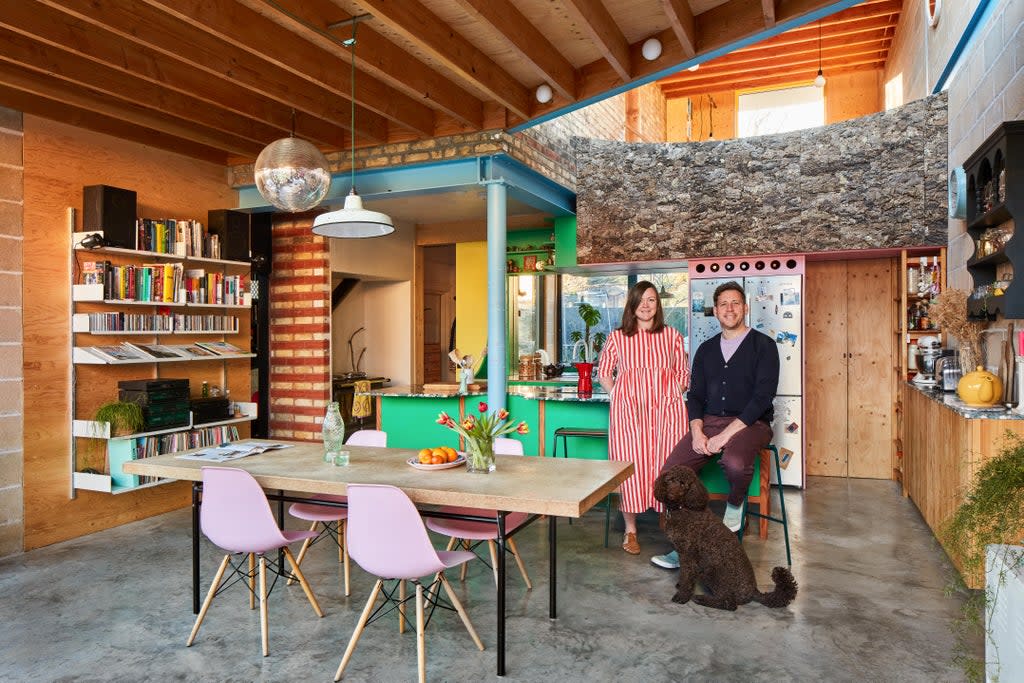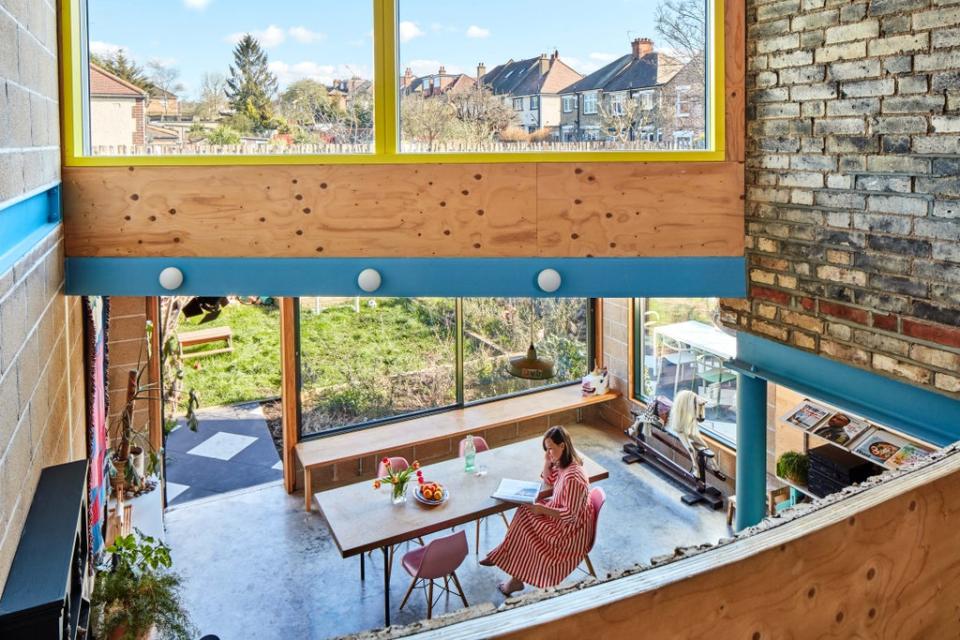Inside the playful north-east London extension inspired by Epping Forest that’s just won a top renovation award

In the centre of Gillian Lambert and Geoff Shearcroft’s extra-wide Victorian hallway is a swing, clamped to a blue metal ceiling beam and hanging in front of the entrance to the kitchen. You can’t miss it.
Light parquet flooring runs underfoot with a long, wooden bench to the left for shoes.
Deliberately perched on top of another piece of bespoke cabinetry in the hallway are Woody and Buzz figurines from Toy Story. Welcome to the Highams Park playhouse of adventure and experimentation.
An east London rite of passage
The architect couple and their children Orla, 14, Jackson, seven, and Margot, six moved in 2015 from Clapton to Walthamstow. Lambert describes this as a “rite of passage”, as east London families push to the periphery of the capital in search of more home and more (or any) outside space for their money.
They spent £620,000 on a semi-detached Victorian home in Highams Park. After a full renovation costing in the region of £200,000 this bogstandard home was transformed into Forest House, fittingly the winner of the Unique Character accolade in New London Architecture’s Don’t Move, Improve! awards 2022 after a mid-Covid project to extend the house as the family grew.

After living in the house for four years, their aim for the family was to “retain the intimacy of the well-proportioned rooms but introduce the spatial generosity and experimental joy of the nearby Epping Forest,” she says.
They got a garden large enough for the dog, several rabbit runs and hutches, and a caravan in need of restoration — which is Shearcroft’s next job. But they also got Epping Forest right on their doorstep, which in turn inspired their renovation.
“We were fascinated by the forest and love spending time there. During the lockdowns we headed there every day for space, play and immersion in nature.
“We wanted our home to capture the essence of the woods,” says Lambert, who runs architectural practice AOC with Shearcroft. Hence its submission name into the DMI awards.

Inspired by nature
A single-storey garage on the end-of-terrace made way for a three-storey stacked wrap-around extension that houses a new kitchen, a garden room, a mezzanine studio overlooking the kitchen and an attic room above that.
The first not-so-subtle nod to the woods comes in the kitchen where the stainless-steel American-style fridge-freezer (and in-built wine rack) sits beneath a suspended cork bark statement wall that connects the original brick side of the house to the new section (the former garage).
The raised wall houses the structural steel beams and sits between the top of the kitchen and the mezzanine studio in one vast triple-height space. “An array of greens in the palette creates the busy calm of the forest,” says Lambert. The vivid green in the kitchen is meant to mimic the colour of lichen.

The cork references to the forest are repeated throughout the house: a smooth cork is used for wardrobes and the side of the bath. The rough bark wall and smooth cork ply are made from tiles sourced from Siesta Cork Tiles in Croydon (siestacorktiles.co.uk).
“Cork is definitely having its moment,” she says. “There are highlights of it around the house and then in some spaces (the kitchen) the volume is turned up like you are standing next to a tree.”
The rear facade is clad in woven hazel to give a wicker basket effect, which frames large, glazed panels above a concrete plinth to add texture, variation and a solid base. Lambert gives the impression they are testing the hazel wood as a sustainable material and will monitor how it weathers.
The woodland theme continues with the exposed wooden beams in the mezzanine studio, which is set up for any creative activity by any member of the family, from architectural drawings to Lego construction.
“We have intentionally stored the paints and Lego up there next to the grown-up stuff, so it doesn’t feel like an office. Laptops can be quickly shoved away, and anyone can take over the space. If the kids get stuck into something creative, they can leave it out, come down for dinner and go back to it,” she says.
Weaving old and new together
On the same first-floor level but in the old part of the house is the master bedroom with wooden floors, antique furniture and painted in Verdigris Green by Edward Bulmer (paints made from plants) with an en suite.
The stairs then run up to the kids’ lair — the attic. Walking up the stairs and through doorways into different rooms and sections, you weave through the old and new parts of the house, with exposed brick, steel and new timber beams signposting the two eras.
The vast attic, painted in Pastel Turquoise by RAL, has a chimney stack running through the centre and naturally divides into three spaces for the three children. Across the landing is a smaller guest room with a day bed that can be transformed into a teenage bedroom when Orla wishes to escape her younger siblings.

The snug in the old part of the house is another peaceful retreat. Painted in a dark green (Obsidian Green by Little Greene) it gets the natural morning light and is where the couple drink their coffee first thing with the papers. In the evening, the family can snuggle up and read in the ambient light or play music.
In fact, as well as woodland colours and materials, the other theme that stands out is the use of light throughout the home. There are lanterns positioned in the voids of the roof above the triple-height space allowing glimpses of sky, as if looking up from the forest floor.
The glazed panels at the back of the home, which slide back, bring light into the kitchen but also create connection with the wild and fragrant garden — tall verbena and wildflowers brush against the windows and rainwater runs into a collecting fountain. From the back of the house there are views across neighbouring gardens towards Epping Forest.
Staying warm sustainably
Forest House does not simply pay homage to the woods in name and style. The couple have considered the impact of their project on the local natural environment, too.They kept the original walls to reduce the embodied carbon of the property — this is the amount of carbon produced in the construction process, as opposed to operational carbon, which is the day-to-day carbon footprint of the home once it is fully built.

The rear and unattached side of the house (the old garage and what is the end of the terrace) was wrapped in the extension to better insulate the property. The new roof and the dormer are also well-insulated, she explains, to provide a “warm hat to the home”. Underfloor heating in the extension’s polished concrete floor has proved sufficient to keep the use of radiators in the upper floors to a minimum.
Above all else, and regardless of its architectural quirks, it’s a warm family home with plenty of personality. There’s the structural totem holding the kitchen up, which is covered in art and height markers as the children get taller. It is almost an extra family member.
On the stripped-back wooden doors through to the pantry and bike store in the old garage there’s a little smiley face around the handle carved in by the builders — at Lambert’s request. “Even when this house is filled with activity, you can always find your own space,” she says. “There are lots of rooms to retreat for our family of five, and yet no one disappears.”
How to create a fun family home
Store and display kids’ toys alongside adults’ work items to make spaces feel family friendly
Keep the adults’ bedroom on a separate floorfrom the kids’ rooms if space permits
Don’t be afraid of “silly” touches such as the smileyface on the bike store door handles
Colour is the ultimate mood enhancer
Create space for people to have privacy as much as for shared family time

 Yahoo Movies
Yahoo Movies 
